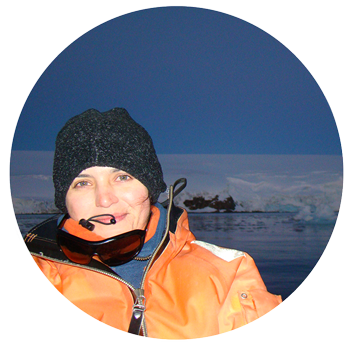
Doctora en Ciencias Naturales
Investigadora asistente
https://orcid.org/0000-0002-3704-1696
Grupo:
División Ictiología del Instituto Antártico Argentino (IAA)
Línea de investigación
El proyecto del cual participo es sobre ecología general (alimentación, reproducción, edad y crecimiento e interacción con predadores) y evolución (flotabilidad y ecomorfología) de peces antárticos del Arco de Scotia (Islas Georgias del Sur, Orcadas del Sur, Shetland del Sur y oeste de la Península Antártica). Actualmente realizo análisis de biomarcadores en especies del Suborden Notothenioidei para la determinación de las relaciones tróficas en comunidades marinas costeras.
Proyectos
-ANTARCTIC WILDLIFE RESEARCH FUND. Project 12. Biomarkers approach: Trophic ecology of inshore nototheniid fish at Potter Cove, Antarctica, the importance of krill in their diets. The Antarctic Wildlife Research Fund (AWR). Dirección: Dra Eugenia Moreira.
-PICT-2018- 03310. Resolución N° 401/19 Monitoreo del impacto de la pesquería y ecología de peces antárticos de interés comercial (Suborden Notothenioidei) del área de las Islas Shetland del Sur, con fines de conservación. Dirección: Dr. Esteban Barrera Oro. Grupo responsable: Eugenia Moreira, Gustavo Daneri y Enrique Marschoff.
-PIP 2017-2019 GI 11220170100219CO, Resolución 2018-8-APN-DIR#CONICET. Ecología de peces antárticos con fines de conservación: aspectos reproductivos y relaciones tróficas en nototenoideos (Orden Perciformes, Suborden Notothenioidei) de interés comercial del área de las Islas Shetland del Sur. Dirección: Dr. Esteban Barrera Oro
-PICTA-100. Instituto Antártico Argentino. “Ecología general de peces antárticos e impacto de la pesca comercial”. Dirección: Dr. Esteban Barrera Oro
Publicaciones seleccionadas
1. Novillo M, Moreira E, Macchi G, Barrera-Oro E (2019) Reproductive effort in Chaenocephalus aceratus validated by gonadal histology: inshore sites serve as spawning grounds for some notothenioids. Polar Biol 42:1959–1972. https://doi.org/10.1007/s00300-019-02571-8
2. Barrera-Oro E, Moreira E, Seefeldt MA, et al (2019) The importance of macroalgae and associated amphipods in the selective benthic feeding of sister rockcod species Notothenia rossii and N. coriiceps (Nototheniidae) in West Antarctica. Polar Biol 42:317–334. https://doi.org/10.1007/s00300-018-2424-0
3. Seefeldt MA, Weigand AM, Havermans C, et al (2018) Fishing for scavengers: an integrated study to amphipod (Crustacea: Lysianassoidea) diversity of Potter Cove (South Shetland Islands, Antarctica). Mar Biodiv 48:2081–2104. https://doi.org/10.1007/s12526-017-0737-9
4. Piacentino GLM, Moreira E, Barrera-Oro E (2018) Early stages of notothenioid fish from Potter Cove, South Shetland Islands. Polar Biol 41:2607–2613. https://doi.org/10.1007/s00300-018-2366-6
5. Novillo M, Moreira E, Macchi G, Barrera-Oro E (2018) Reproductive biology in the Antarctic bathydraconid dragonfish Parachaenichthys charcoti. Polar Biol 41:2239–2248. https://doi.org/10.1007/s00300-018-2359-5
6. Marina TI, Salinas V, Cordone G, et al (2018) The Food Web of Potter Cove (Antarctica): complexity, structure and function. Estuar Coast Shelf Sci 200:141–151. https://doi.org/10.1016/j.ecss.2017.10.015
7. Ríos JM, Lana NB, Ciocco NF, et al (2017) Implications of biological factors on accumulation of persistent organic pollutants in Antarctic notothenioid fish. Ecotoxicol Environ Saf 145:630–639. https://doi.org/10.1016/j.ecoenv.2017.08.009
Últimas publicaciones
Redes académicas
